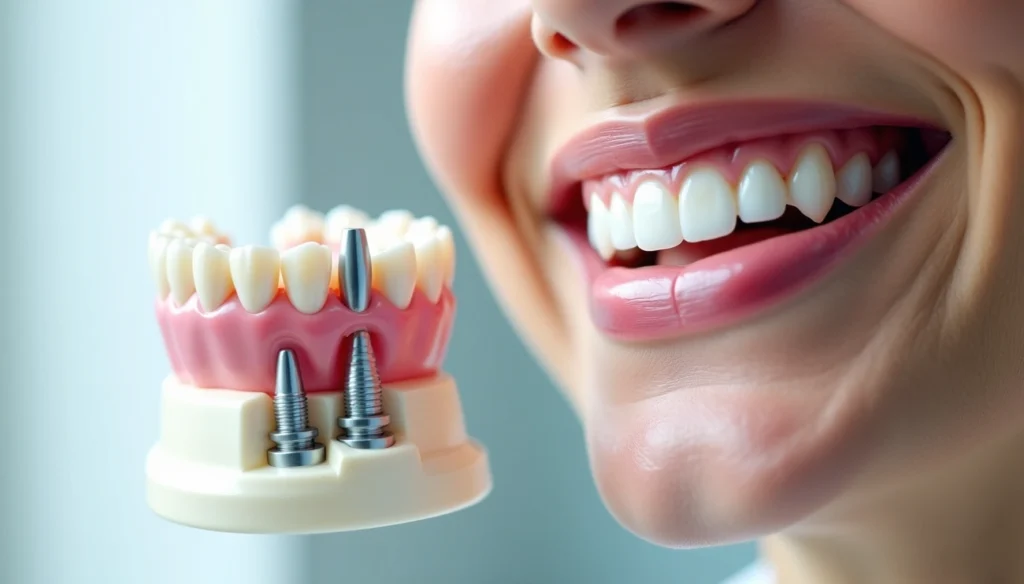
All-on-4 dental implants have transformed tooth replacement with a remarkable 98% success rate, which stands substantially higher than other options. Patients who don’t deal very well with multiple missing teeth now have a chance to restore their function and confidence through this groundbreaking solution.
Missing teeth change people’s appearance, feelings, and their approach to daily life. All-on-4 dental implants solve this challenge by using strategically placed implants with prosthetics that hold replacement teeth securely. These denture implants take just one day to complete under expert care. Patients leave with their new smile without long waiting periods. The growing popularity of this procedure comes with essential facts that go beyond marketing materials. Patients should understand these aspects before they invest in this treatment.
This piece gets into what dentists might not emphasize about All-on-4 implants – from unexpected physical sensations to maintenance needs over time. These hidden truths will help readers learn about whether this dental solution matches their needs and expectations.
What are All-on-4 Dental Implants?
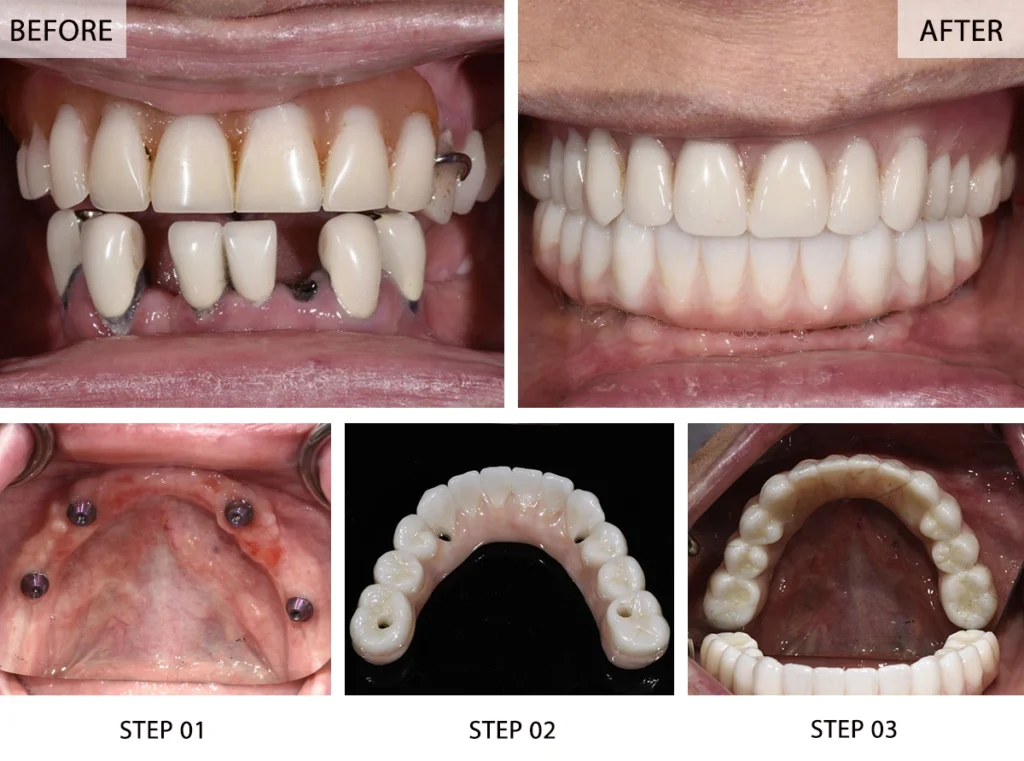
Image Source: NYC Dental Implants Center
All-on-4 dental implants offer a fresh take on full-arch tooth replacement. This technique needs just four strategically placed titanium implants per jaw to support an entire arch of prosthetic teeth. Two implants sit vertically in the front of the jaw, while the other two angle in the back to make the most of existing bone. This creates a solid base for a fixed, permanent denture that works just like natural teeth.
How they differ from traditional implants
All on four dental implants stand out from traditional methods in both efficiency and design. Traditional implants need one post for each missing tooth, but the all on 4 technique restores a full arch with just four implants. On top of that, it places the back implants at a 45-degree angle. This smart positioning makes the best use of available bone and often eliminates bone grafting.
The traditional approach needs more surgeries and longer healing times between procedures. All on 4 implants let patients get their temporary teeth the same day as the implant placement. Traditional methods need more bone density and volume to work well, but all-on-4 works great even for patients who have moderate bone loss.
Why they’re popular in 2025
All on 4 dental implants keep gaining popularity in 2025 because they solve many common implant treatment challenges. These implants cost much less than traditional methods that might need 8-10 implants for full-mouth restoration. The efficient procedure means patients can get their new teeth in just one day.
These implants help keep your jawbone healthy too. They stimulate the bone like natural tooth roots and prevent the deterioration that usually happens after tooth loss. This helps maintain your facial structure and appearance as time goes by.
Who they are designed for
All-on-4 denture implants work best if you have lost most or all teeth in your upper or lower jaw. They’re a great choice if you want something better than removable dentures that might slip when you eat or speak.
You’ll need healthy gums to be a good candidate. While all on four dental implants don’t need as much bone density as traditional ones, you still need enough jawbone structure for successful placement. Some health conditions like uncontrolled diabetes or blood clotting disorders might affect whether you can get these implants.
The All-on-4 Procedure: What Dentists Usually Tell You
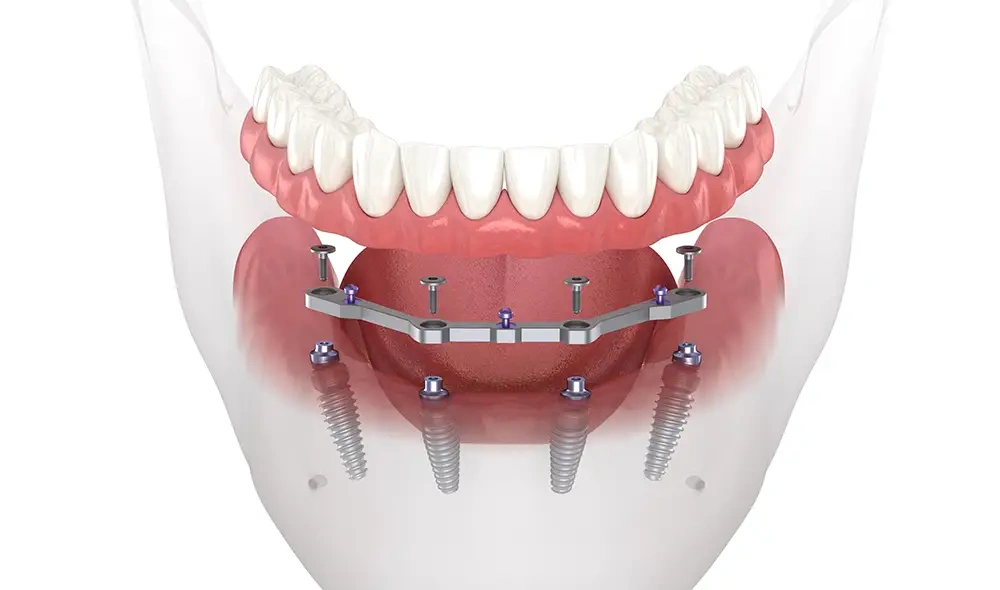
Image Source: Twogether Dental
Patients often ask about all on 4 dental implants, and dentists explain a simple process that gives results the same day. Here’s what prominent dental professionals say about this increasingly popular procedure.
Step-by-step overview of the process
The dental team starts with a complete consultation to get a full picture of your oral health through X-rays and create a treatment plan. Patients sleep comfortably under general anesthesia during the procedure.
The surgeon removes any problem teeth and places four titanium implants per arch. Two straight implants go in front while two angled ones fit in the back. This smart angle design taps into the available bone and often eliminates bone grafting needs.
A temporary bridge attaches right after implant placement. Patients walk out with working teeth that same day. This temporary solution stays in place while healing happens, until the permanent teeth are ready.
Expected recovery timeline
The first few days bring some swelling, bruising, and discomfort. You can get back to regular activities within a week. Strenuous activities should wait for about 10 days.
Soft foods are needed for 6-8 weeks while osseointegration happens – this is how implants fuse with your jawbone. This vital phase usually takes 4-6 months.
The final step comes after complete healing – replacing your temporary bridge with a permanent, custom-designed one.
Common benefits highlighted by clinics
Dental professionals point out several advantages of all on 4 dental implants. The procedure causes less discomfort than traditional methods. Patients see immediate improvements in their smile that same day.
The results can be long-lasting – with good care, all on 4 dental implants can last a lifetime. These implants provide better stability than removable dentures.
8 Hidden Truths About All-on-4 Dental Implants
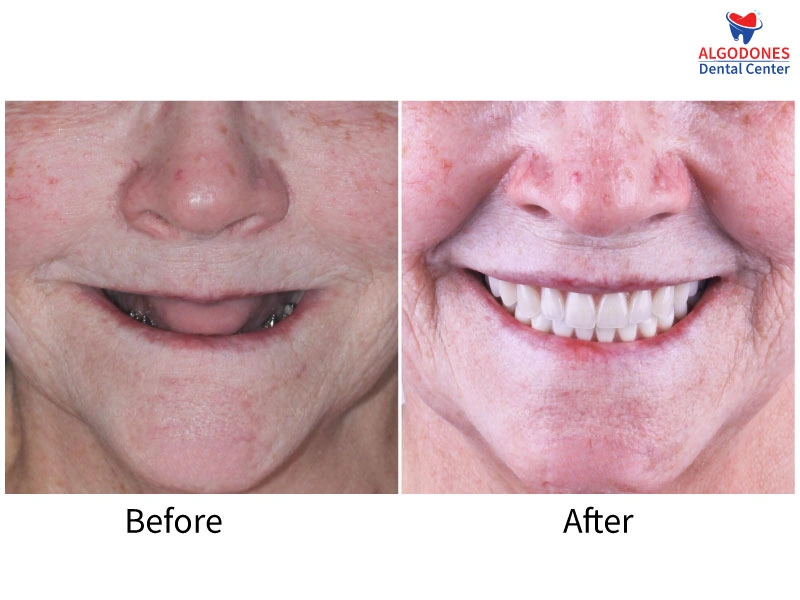
Image Source: Algodones Dental Center
Before you decide on all on 4 dental implants, there are several things you should know that you won’t find in the brochures or hear during consultations.
1. They may feel bulkier than expected
Patients often tell us their all on 4 dental implants feel thicker than their natural teeth. This happens because the prosthesis doesn’t just replace teeth – it also fills in missing gum and bone tissue. The horseshoe shape and stability across the arch make your mouth feel fuller than before.
2. Speech changes can take weeks to adjust
You might have trouble speaking clearly right after getting all on four dental implants. Many patients struggle with certain sounds like “s,” “d,” or “f”. Air can slip through tiny gaps between your gums and prosthesis. The good news is most people adapt within weeks, and 84% say they’re happy with their speech afterward.
3. Implant failure is rare but possible
The success rates are high, but implant failure happens in about 5% of cases. Research shows patient success rates of 94.8% at five years and 93.8% at ten years. Smoking makes failure three times more likely, so picking the right patients plays a vital role in getting the best results.
4. Bone loss can still occur over time
Your bone can still deteriorate even with implants. All on 4 dental implants help stimulate bone growth and stop resorption. In spite of that, issues like peri-implantitis can cause ongoing bone loss. You’ll need regular checkups since bone typically loses 0.19 mm each year.
5. Gum color mismatch is more common than you think
The fake gum part of all on 4 denture implants might not match your natural gum color perfectly. Your gum tissue can also change color over time from conditions like gum disease. This might mean you need your prosthesis refinished or replaced.
6. Maintenance is more complex than advertised
Brushing alone isn’t enough. You’ll need water flossers or super floss daily to keep food from getting stuck under the devices. You should get professional cleaning twice a year and replace screws every few years. Skip these steps and you risk getting peri-implantitis and implant failure.
7. Not all materials used are equally durable
The quality of materials makes a big difference in how long they last. Zirconia stands out for its strength and durability, while acrylic bridges wear down faster. No all on 4 dental implant bridge materials last forever – even the best ones can break under certain conditions.
8. Some patients need additional cosmetic work
The original procedure might not be the end of your journey. Some patients need gum grafting if implant metal shows through. Those with certain bite issues might also need extra adjustments to get both the function and look they want.
What Your Dentist Might Not Emphasize Enough
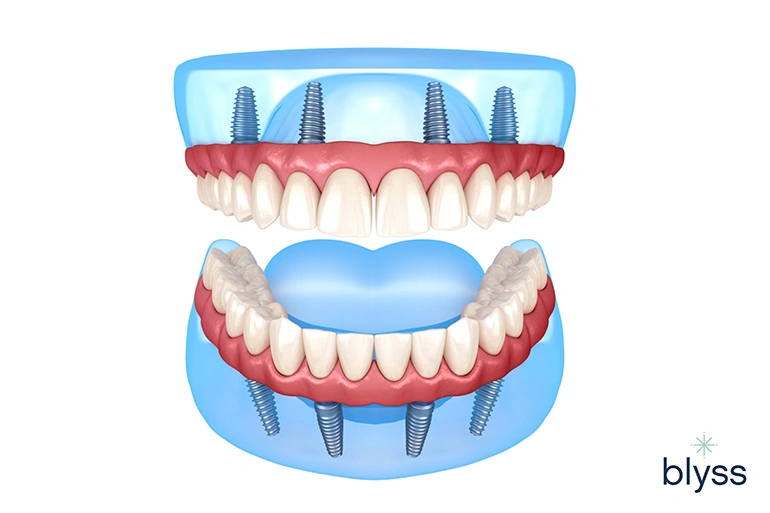
Image Source: Blyss Dental
The promotional material for all on 4 dental implants tells only part of the story. Patients need to understand several significant factors before they move forward with treatment.
The importance of surgeon and lab experience
A surgeon’s expertise directly affects outcomes. The practitioner’s skill level will give a precise implant placement that reduces complications risk. The laboratory’s craftsmanship of your bridge can determine long-term success. The numbers tell an interesting story – specialists spend about 35% of their time fixing other dentists’ mistakes. Results work best with practitioners who do All-on-4 procedures regularly instead of those who only complete a few each month. Zirconia bridges offer the best durability if crafted properly.
The real cost beyond the original quote
Expect to pay 3-4 times more than the advertised price. The original quotes usually cover just the titanium implant posts, not the abutments, prostheses, or required procedures. IV sedation costs can add thousands of dollars. A complete arch restoration ranges from $20,000 to $50,000. High-quality materials like zirconia add substantial costs.
The role of lifestyle habits in implant success
Smokers face implant failure rates of nearly 15%, while non-smokers see just 1.4%. Healing slows down with medical conditions like diabetes. Physical activity cuts gum disease risk by about 50%. Better blood flow comes from proper hydration, which speeds up healing.
Why second opinions matter
Extra evaluations help patients avoid complications and spot issues that might be missed at the time of the first assessment. Patients get a chance to compare treatment approaches and pricing options. This becomes vital given the substantial investment all on four dental implants need.
Conclusion
All-on-4 dental implants are changing lives for people who struggle with tooth loss. These implants bring stability, better function, and improved looks that regular dentures can’t provide. You need realistic expectations and a clear picture of what’s involved before making this major dental investment.
The 98% success rate sounds impressive, but you should weigh both the good and not-so-good points first. Real issues like bulky feeling implants, temporary speech changes, and upkeep needs deserve your attention. Your long-term happiness depends on your surgeon’s skill, quality materials, and proper follow-up care.
Most dental offices talk up quick results and ease of treatment but stay quiet about lifetime costs and commitment. The final cost often ends up 3-4 times higher than advertised. Your lifestyle choices play a huge role too – smokers are ten times more likely to have implant failure than non-smokers.
All-on-4 implants solve many denture problems but come with their own set of duties. Your new dental work needs regular checkups, daily cleaning routines, and replacement parts from time to time.
You should look beyond marketing when deciding about All-on-4 dental implants. Getting several expert opinions helps you spot possible problems and find a treatment plan that fits your needs. These advanced dental solutions can change your life, but they work best when you understand what you’re getting into. A complete understanding, not just sales pitches, helps you decide if All-on-4 implants are right for your tooth replacement needs.
FAQs
Q1. How long do All-on-4 dental implants typically last? With proper care and maintenance, All-on-4 dental implants can last a lifetime. However, the prosthetic teeth may need replacement every 10-15 years due to normal wear and tear.
Q2. What is the average cost of All-on-4 dental implants? The cost of All-on-4 dental implants typically ranges from $20,000 to $50,000 per arch. However, the final price can vary based on factors like materials used, additional procedures needed, and the dentist’s expertise.
Q3. Are there any lifestyle changes required after getting All-on-4 implants? Yes, patients should maintain excellent oral hygiene, avoid smoking, and attend regular dental check-ups. It’s also important to use specialized cleaning tools like water flossers to prevent food accumulation under the prosthesis.
Q4. How long does it take to adjust to All-on-4 dental implants? Most patients adapt to their new implants within a few weeks. However, it may take some time to get used to the feel of the implants and to overcome temporary speech difficulties, which typically resolve within 2-3 weeks.
Q5. Can All-on-4 implants fail, and what are the signs of failure? While rare, All-on-4 implants can fail. Signs of failure include persistent pain, swelling, implant mobility, difficulty chewing, and visible bone loss around the implant. If you experience any of these symptoms, consult your dentist immediately.

![Mini Dental Implants vs Traditional: Expert Guide for Better Choice [2025]](https://dentalimplantinsights.com/wp-content/uploads/2025/08/Mini-Dental-Implants-vs-Traditional-1024x584.webp)
![The Real Difference Between Zirconia and Titanium Dental Implants [2025 Guide]](https://dentalimplantinsights.com/wp-content/uploads/2025/08/The-Real-Difference-Between-Zirconia-and-Titanium-Dental-Implants-2025-Guide-1024x682.webp)